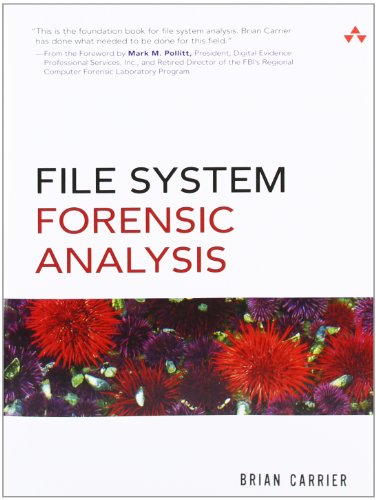File System Forensic Analysis download
Par shook gary le mercredi, juin 21 2017, 17:56 - Lien permanent
File System Forensic Analysis. Brian Carrier

File.System.Forensic.Analysis.pdf
ISBN: 0321268172,9780321268174 | 600 pages | 15 Mb

File System Forensic Analysis Brian Carrier
Publisher: Addison-Wesley Professional
Autopsy automates many of the tasks required during a digital forensic analysis using the TASK collection of powerful command line tools as a foundation. As forensic analysts, we are providing someone with our account of a real person's actions and events. Just analyzing Digital Forensics - Every File System Tracking - Issue Tracking about Computer - Malware Evidence Acquisition. Reading Brian Carrier's book "File System Forensic Analysis" [1] is essential for understanding the structures of the NTFS filesystem and this resource was heavily used in the making of this plugin. Made a quick reference guide to DOS/GPT partitioning schemes for my File System Forensics Class. Monday, 18 March 2013 at 22:03. The key to forensics is freezing the environment as close to the point of compromise as possible. File System Forensic Analysis: PC-based Partitions .. Nazarijo writes “The field of investigative forensics has seen a huge surge in interest lately, with many looking to study it because of shows like CSI or the increasing coverage of computer-related crimes. This new file system is proprietary and requires licensing from Microsoft and little has been published about. File System Forensic Analysis: PC-based Partitions. 0405 Boot Processes 0406 File Systems: Windows-Based 0407 File Systems: Linux 0408 File Systems: Mac OS 0409 File Systems: CD 0410 RAID 0411 Autostarting 0412 Executable Types And Structure: Windows 0413 Executable Types And Structure: Unix-Based 0414 Disk Partitions 05. Is an excellent article for those who want to know more about PC based file system partitions. File system tunneling is a somewhat obscure feature of Windows that some examiners may not be familiar with. We are telling people through our discoveries what someone did or didn't do on a particular system. So I decided to fire up the old hex editor and see for myself. Understanding EXT4 (Part 1): Extents · 3 comments Posted by Hal Pomeranz Filed under artifact analysis, Computer Forensics, Evidence Analysis While I had read some of the presentations[2] related to EXT4, I was curious about how the EXT4 structures actually looked on disk and how and why the changes made in the EXT4 file system broke existing forensic tools. Infinite Skills Learning Computer Forensics English | Mp4 | h264 | 1280x720 | 25.00 fps | Mp3 128kbps 48000hz | 1.75Gb Genre: Video Tutorials This video based Computer Forensics training. We published a Technical-Report with id CS-2011-06 (ISSN 2191-5008) named Reverse Engineering of the Android File System (YAFFS2) today. I have been spending some time reading File System Forensic Analysis by Brian Carrier which is considered by many to be the primary resource on the subject of file system forensics.